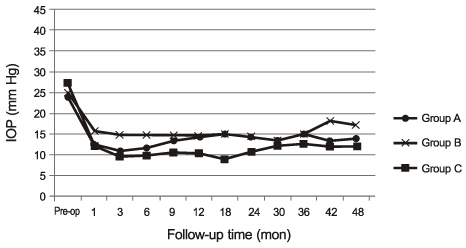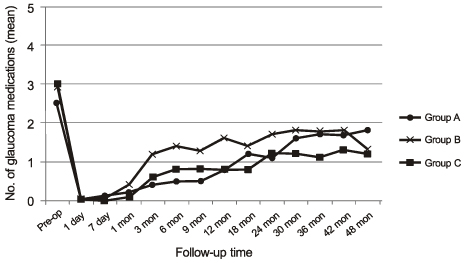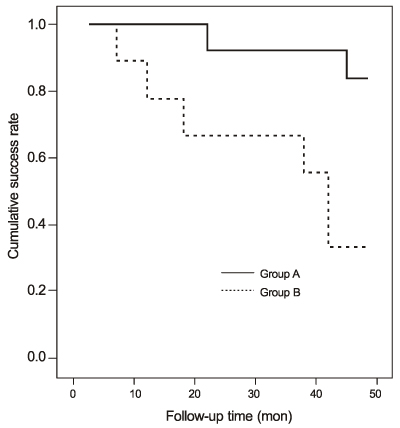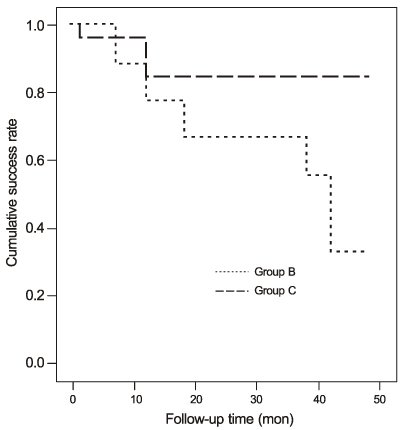J Korean Ophthalmol Soc.
2012 Aug;53(8):1124-1130. 10.3341/jkos.2012.53.8.1124.
Effects of Mitomycin C on Trabeculectomy Outcomes in Patients Who Preoperatively Used Prostaglandin Ophthalmic Solution
- Affiliations
-
- 1Department of Ophthalmology, Chungbuk National University College of Medicine, Cheongju, Korea. smh@chungbuk.ac.kr
- KMID: 2215955
- DOI: http://doi.org/10.3341/jkos.2012.53.8.1124
Abstract
- PURPOSE
To investigate whether mitomycin C (MMC) results in an improved trabeculectomy outcome in primary open-angle glaucoma patients who preoperatively used prostaglandin (PG) ophthalmic solution.
METHODS
The subjects consisted of three groups of primary open-angle glaucoma patients who underwent trabeculectomy. Group A consisted of 17 patients who did not use PG ophthalmic solution preoperatively, while Group B consisted of ten patients who used PG ophthalmic solution for at least three months but were not treated with MMC during the operation, and Group C consisted of 14 patients who used PG ophthalmic solution for at least three months and were treated with MMC during the operation. The operation was considered successful when the intraocular pressure ranged from 6 to 18 mmHg, regardless of application of ocular hypotensive agents.
RESULTS
Four years after the operation, differences of the cumulative success rate between Group A and B (p = 0.008) and between Group B and Group C (p = 0.036) were statistically significant, but differences between Group A and C were not (p = 0.813) (Log rank test results).
CONCLUSIONS
The cumulative success rate of trabeculectomy in primary open-angle glaucoma patients who used PG ophthalmic solution for at least three months was lower than that of patients who did not use PG ophthalmic solution. However, the intraoperative administration of MMC increased the cumulative success rate of trabeculectomy in patients who did use PG ophthalmic solution for at least three months to a level similar to patients who did not use PG ophthalmic solution.
Keyword
Figure
Reference
-
1. Friedman DS, Wilson MR, Liebmann JM, et al. An evidence-based assessment of risk factors for the progression of ocular hypertension and glaucoma. Am J Ophthalmol. 2004. 138:3 Suppl. S19–S31.2. Nouri-Mahdavi K, Brigatti L, Weitzman M, Caprioli J. Outcomes of trabeculectomy for primary open-angle glaucoma. Ophthalmology. 1995. 102:1760–1769.3. Park JS, Kang IS, Lee JH. The effect of topical antiglaucomatous medication on the outcome of trabeculectomy. J Korean Ophthalmol Soc. 1999. 40:1352–1361.4. Wong TT, Mead AL, Khaw PT. Prolonged antiscarring effects of ilomastat and MMC after experimental glaucoma filtration surgery. Invest Ophthalmol Vis Sci. 2005. 46:2018–2022.5. Chen CW. Enhanced intraocular pressure controlling effectiveness of trabeculectomy by local application of mitomycin-C. Trans Asia Pacific Acad Ophthalmol. 1983. 9:172–177.6. Sherwood MB, Grierson I, Millar L, Hitchings RA. Long-term morphologic effects of antiglaucoma drugs on the conjunctiva and Tenon's capsule in glaucomatous patients. Ophthalmology. 1989. 96:327–335.7. Johnson DH, Yoshikawa K, Brubaker RF, Hodge DO. The effect of long-term medical therapy on the outcome of filtration surgery. Am J Ophthalmol. 1994. 117:139–148.8. Broadway DC, Grierson I, O'Brien C, Hitchings RA. Adverse effects of topical antiglaucoma medication. II. The outcome of filtration surgery. Arch Ophthalmol. 1994. 112:1446–1454.9. Gwynn DR, Stewart WC, Pitts RA, et al. Conjunctival structure and cell counts and the results of filtering surgery. Am J Ophthalmol. 1993. 116:464–468.10. Watson P, Stjernschantz J. The Latanoprost Study Group. A six-month, randomized, double-masked study comparing latanoprost with timolol in open-angle glaucoma and ocular hypertension. Ophthalmology. 1996. 103:126–137.11. Nagasubramanian S, Sheth GP, Hitchings RA, Stjernschantz J. Intraocular pressure-reducing effect of PhXA41 in ocular hypertension. Comparison of dose regimens. Ophthalmology. 1993. 100:1305–1311.12. Feldman RM. Conjunctival hyperemia and the use of topical prostaglandins in glaucoma and ocular hypertension. J Ocul Pharmacol Ther. 2003. 19:23–35.13. The AGIS Investigators. The Advanced Glaucoma Intervention Study (AGIS): 7. The relationship between control of intraocular pressure and visual field deterioration. The AGIS Investigators. Am J Ophthalmol. 2000. 130:429–440.14. Cairns JE. Trabeculectomy. Preliminary report of a new method. Am J Ophthalmol. 1968. 66:673–679.15. WuDunn D, Cantor LB, Palanca-Capistrano AM, et al. A prospective randomized trial comparing intraoperative 5-fluorouracil vs mitomycin C in primary trabeculectomy. Am J Ophthalmol. 2002. 134:521–528.16. Goldenfeld M, Krupin T, Ruderman JM, et al. 5-Fluorouracil in initial trabeculectomy. A prospective, randomized, multicenter study. Ophthalmology. 1994. 101:1024–1029.17. Lee HK, Seong GJ. The additive effect of Xalatan (0.005% Latanoprost) to beta adrenergic receptor blocker in patients with open angle glaucoma. J Korean Ophthalmol Soc. 1998. 39:169–176.18. Stewart WC, Kolker AE, Stewart JA, et al. Conjunctival hyperemia in healthy subjects after short-term dosing with latanoprost, bimatoprost, and travoprost. Am J Ophthalmol. 2003. 135:314–320.19. Parrish RK, Palmberg P, Sheu WP. XLT Study Group. A comparison of latanoprost, bimatoprost, and travoprost in patients with elevated intraocular pressure: a 12-week, randomized, masked-evaluator multicenter study. Am J Ophthalmol. 2003. 135:688–703.20. Skuta GL, Beeson CC, Higginbotham EJ, et al. Intraoperative mitomycin versus postoperative 5-fluorouracil in high-risk glaucoma filtering surgery. Ophthalmology. 1992. 99:438–444.21. Hong SJ, Moon SC, Yoo KW, Rho SH. The effects of mitomycin C on trabeculectomy. J Korean Ophthalmol Soc. 1996. 37:1570–1575.22. Lee JH, Park JS, Cho JH. Surgical outcome and complications of preoperative subconjunctival injection of mitomycin C in filtering surgery. J Korean Ophthalmol Soc. 2002. 43:297–302.23. Song S, Yoon KC, Yang KJ. Long-term results of primary trabeculectomy in glaucoma. J Korean Ophthalmol Soc. 2003. 44:677–684.24. Hong C, Hyung SM, Song KY, et al. Effects of topical mitomycin C on glaucoma filtration surgery. Korean J Ophthalmol. 1993. 7:1–10.
- Full Text Links
- Actions
-
Cited
- CITED
-
- Close
- Share
- Similar articles
-
- The Effect of Mitomycin C on Primary Trabeculectomy: Comparative Study in the Same Person
- Effects of postoperative mitomycin C eyedrop on trabeculectomy in refractory glaucoma patients
- Surgical Results of Repeated Trabeculectomy in Congenital Glaucoma
- Midd-term effects of trabeculectomy with mitomycin C in neovascular glaucoma patients
- Trabeculectomy with Mitomycin C(MMC)






